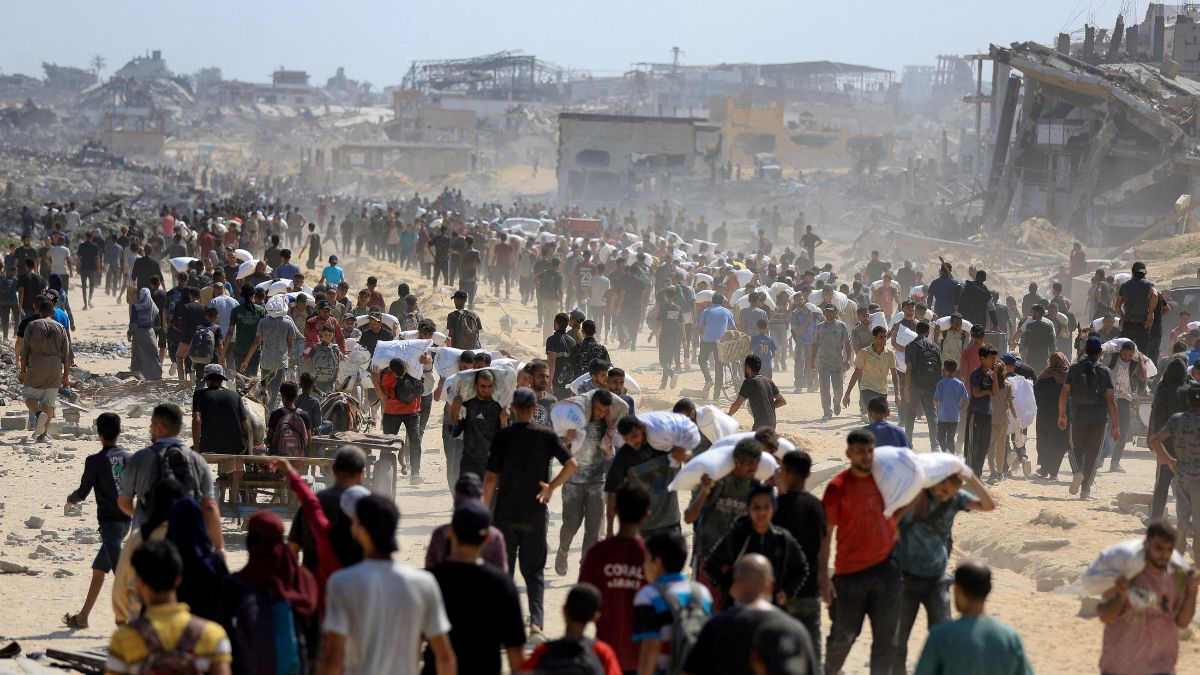After 21 months of war, Gaza has seen 70 per cent of its buildings either destroyed or damaged, leaving the Palestinian enclave buried under millions of tonnes of rubble and shrouded in darkness, according to data from the United Nations and Nasa, analysed by AFP.
In response to the 2023 Hamas-led assault that sparked the conflict and resulted in 1,219 deaths on the Israeli side — mostly civilians, according to an AFP count based on official sources — the Israeli military has continuously bombarded the densely populated strip, which spans 365 square kilometres (141 square miles).
53 million tonnes of rubble
According to the health ministry operating under the Hamas-led administration, Israel’s offensive has claimed the lives of 59,219 people in Gaza, the majority of them civilians.
The destruction on the ground has been immense: by April 4, 2025, the UN’s satellite analysis agency, UNOSAT, reported that 174,500 buildings had been levelled by the Israeli strikes.
UNOSAT has estimated the resulting debris at 53.5 million tonnes — around ten times the mass of Egypt’s Great Pyramid of Giza.
That equates to approximately 146 kilogrammes of rubble for every square metre of land in the enclave, according to the same UN body.
While there were already buildings in Gaza that had been razed by Israel before the war, the scale of destruction since October 2023 is 18 times greater than the debris accumulated from Israeli strikes over the past 15 years combined.
Asbestos and toxic hazards
A July publication by the UN Environment Programme (UNEP) warned that the vast quantity of rubble contains hazardous substances that could jeopardise public health in Gaza.
UNEP estimated that debris from older buildings may include 3.7 tonnes of asbestos, along with 2.6 tonnes of toxic waste originating from destroyed industrial facilities.
The agency noted that several densely populated refugee camps — such as those in Jabalia, Nuseirat, Maghazi, Khan Yunis, and Rafah—are situated dangerously close to “debris potentially contaminated with asbestos”.
Only half of hospitals ‘partially’ operational
Hospitals and clinics have also taken a heavy toll during Israeli airstrikes. Israel alleges that Hamas uses hospitals as bases or hideouts to conduct operations.
As of June 30, just 18 of Gaza’s 36 hospitals were “partially” functional, according to UN figures.
Out of a total of 163 healthcare facilities, only 63 — or fewer than 40 per cent — were deemed fit to provide any medical care.
Nearly 90% of schools affected
Schools have similarly been ravaged by the ongoing bombardment. Many were repurposed as shelters for displaced families, but the Israeli military claims Hamas has used school premises to conceal its fighters.
UNICEF, in its April 1 report, stated that out of 564 documented schools, 501 had suffered damage — meaning almost 90 percent had been affected.
Of these, 95 schools may have sustained severe damage, while 406 were hit directly.
Night-time illumination falls sevenfold
Prior to the war, residents of the Gaza Strip received grid electricity for about 12 hours a day, according to data from the UN Office for the Coordination of Humanitarian Affairs (OCHA).
By 2024, that access had completely disappeared.
The sole power plant in Gaza shut down in the early phase of the conflict due to a lack of fuel. Meanwhile, power lines from Israel — which had previously supplied a significant portion of Gaza’s energy — were cut off.
Before the war, the power plant and Israeli supply lines jointly fulfilled 43 per cent of Gaza’s electricity demand.
The rest had already gone unmet.
Now, the enclave is plunged into near-total darkness once night falls.
Using Nasa’s BlackMarble project, which tracks ground-level light emissions (radiance), AFP analysed nighttime light levels.
From January to May 2025, the average nighttime radiance in Gaza had fallen to one-seventh of the levels seen from May to September 2023 — before the war began.
In Gaza City, the reduction was even starker, with nighttime brightness down by a factor of 16.
The only zone with illumination levels similar to pre-war figures was the Philadelphi Corridor, a narrow strip of land along Gaza’s border with Egypt, now entirely controlled by the Israeli military.
Also Watch:
With inputs from AFP


)

)
)
)
)
)
)
)
)



